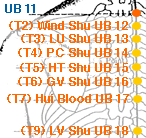UB 17
Acupuncture Point Theory
UB 17 Acupuncture Point Applications and Theory
 The acupuncture point "UB 17" , 膈俞, is represented by "Ge Shu" in pinyin and "Diaphragm Shu" in english and may be found:
The acupuncture point "UB 17" , 膈俞, is represented by "Ge Shu" in pinyin and "Diaphragm Shu" in english and may be found:
1.5 cun lateral to GV 9, level with T7.
Of many possible clinical applications, it may be considered to influence the following issues/symptoms:
- Hui-meeting Point of the Blood, useful for all Blood related conditions. Classically combined with UB 19 to create the "Four Flowers" which is used to nourish the Blood, although in clinical practice UB 18 & UB 19 may used equally as often. These conditions may include coughing or vomiting of blood, blood in the stool.
- For menstrual problems, from deficiency (scanty, light periods, amenorrhea) or stasis (dark clots, dysmenorrhea).
- Important point for red, itchy skin disorders, from heat in the Blood: eczema, carbuncles.
- As the "Diaphgram shu" it harmonizes the chest and descends rebellious qi - problems with diaphragmatic breathing or shortness of breath and other diaphragm related conditions such as belching or hiatal hernia.
- Chest / cardiac pain, also psychological "heart" related conditions - manic depression.
- A range of digestive issues, particularly those involving rebellious qi - vomiting, epigastric pain, reflux.
Ub 17 has the following theoretical associations which serve as important guideposts in designing an effective treatment protocol:
- Diaphragm Back-shu Point
- Hui-meeting Point of the Blood
Explore ub 17 functional groupings theory - MuShu and/or Hui Meeting, or read all point categories and related theory.
A single acupuncture point is not commonly thought of as an empirical way to influence a TCM diagnostic pattern. UB17, however, is a strong candidate to be incorporated into an acupuncture protocol for patients who exhibit: Blood Stagnation, Heat in the Blood and/or Stomach Rebellious Qi
UB 17 may potentially be used, in coordination with a well designed acupuncture treatment protocol, to influence the following conditions: Acid Reflux Disease (GERD), Amenorrhea (Absence of Menstruation), Asthma, Dysmenorrhea (Menstrual Pain - Cramps), Eczema, Manic Depression and/or Nosebleed (Epistaxis)
While not necessarily valid clinically, EX Huatuojiaji at T7 (T7 (Left) innervates the spleen and is an importa…), GV 9 ( Important point for mid-thoracic pain, chest …) and UB 46 (Local Point.) are nearby.
All Content 1999-2025
Chad J. Dupuis / Yin Yang House
Our Policies and Privacy Guidelines
Our Affiliated Clinics
